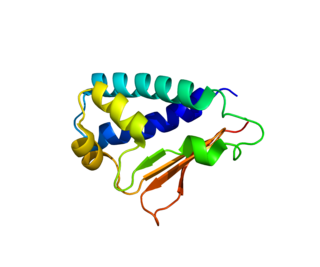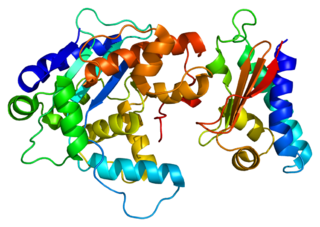CCR4-NOT transcription complex subunit 7 is a protein that in humans is encoded by the CNOT7 gene. [5] [6] [7] [8] It is a subunit of the CCR4-Not deadenylase complex.
CCR4-NOT transcription complex subunit 7 is a protein that in humans is encoded by the CNOT7 gene. [5] [6] [7] [8] It is a subunit of the CCR4-Not deadenylase complex.
The protein encoded by this gene binds to an anti-proliferative protein, B-cell translocation protein 1, which negatively regulates cell proliferation. Binding of the two proteins, which is driven by phosphorylation of the anti-proliferative protein, causes signaling events in cell division that lead to changes in cell proliferation associated with cell-cell contact. The protein has both mouse and yeast orthologs. Alternate splicing of this gene results in two transcript variants encoding different isoforms. [8]
CNOT7 has been shown to interact with:

Mediator is a multiprotein complex that functions as a transcriptional coactivator in all eukaryotes. It was discovered in 1990 in the lab of Roger D. Kornberg, recipient of the 2006 Nobel Prize in Chemistry. Mediator complexes interact with transcription factors and RNA polymerase II. The main function of mediator complexes is to transmit signals from the transcription factors to the polymerase.

Paired amphipathic helix protein Sin3a is a protein that in humans is encoded by the SIN3A gene.

Protein BTG2 also known as BTG family member 2 or NGF-inducible anti-proliferative protein PC3 or NGF-inducible protein TIS21, is a protein that in humans is encoded by the BTG2 gene and in other mammals by the homologous Btg2 gene. This protein controls cell cycle progression and proneural genes expression by acting as a transcription coregulator that enhances or inhibits the activity of transcription factors.

Chromatin assembly factor 1 subunit A is a protein that in humans is encoded by the CHAF1A gene.

Cell division cycle 7-related protein kinase is an enzyme that in humans is encoded by the CDC7 gene. The Cdc7 kinase is involved in regulation of the cell cycle at the point of chromosomal DNA replication. The gene CDC7 appears to be conserved throughout eukaryotic evolution; this means that most eukaryotic cells have the Cdc7 kinase protein.

Protein Tob1 is a protein that in humans is encoded by the TOB1 gene.

Chromatin assembly factor 1 subunit B is a protein that in humans is encoded by the CHAF1B gene.

Homeobox protein Hox-B9 is a protein that in humans is encoded by the HOXB9 gene.

DNA-directed RNA polymerases I and III subunit RPAC1 is a protein that in humans is encoded by the POLR1C gene.

Protein BTG1 is a protein that in humans is encoded by the BTG1 gene.

CCR4-NOT transcription complex subunit 8 is a protein that in humans is encoded by the CNOT8 gene. It is a subunit of the CCR4-Not deadenylase complex.

Small subunit processome component 20 homolog is a protein that in humans is encoded by the UTP20 gene.

60S ribosomal protein L13 is a protein that in humans is encoded by the RPL13 gene.

Protein BTG3 is a protein that in humans is encoded by the BTG3 gene.

CCR4-NOT transcription complex subunit 2 is a protein that in humans is encoded by the CNOT2 gene. It is a subunit of the CCR4-Not deadenylase complex.

Protein Tob2 is a protein that in humans is encoded by the TOB2 gene.

CCR4-NOT transcription complex subunit 1 is a protein that in humans is encoded by the CNOT1 gene.

CCR4-NOT transcription complex subunit 6 is a protein that in humans is encoded by the CNOT6 gene.

CCR4-NOT transcription complex, subunit 4 is a protein that in humans is encoded by the CNOT4 gene.

Carbon Catabolite Repression—Negative On TATA-less, or CCR4-Not, is a multiprotein complex that functions in gene expression. The complex has multiple enzymatic activities as both a poly(A) 3′-5′ exonuclease and a ubiquitin ligase. The exonuclease activity of CCR4-Not shortens the poly(A) tail found at 3' end of almost every eukaryotic mRNA. The complex is present both in the nucleus where it regulates transcription and in the cytoplasm where it associates with translating ribosomes and RNA processing bodies. In mammalian cell, it has a function in the regulation of the cell cycle, chromatin modification, activation and inhibition of transcription initiation, control of transcription elongation, RNA export, nuclear RNA surveillance, and DNA damage repair in nucleus. Ccr4–Not complex plays an important role in mRNA decay and protein quality control in the cytoplasm.